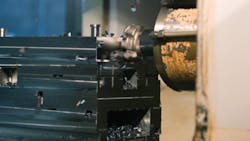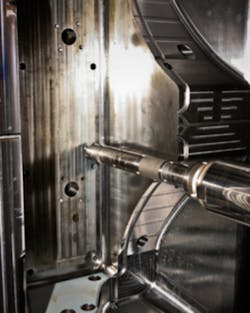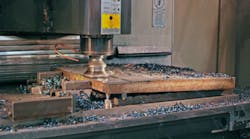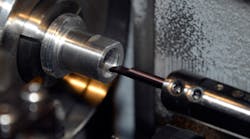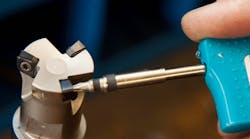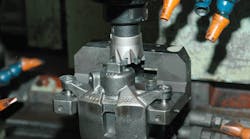North American mold shops, already facing stiffer offshore competition, are also confronting the new challenges of machining deeper cavities and more hostile material combinations. Both Chicago Mold Engineering and Redoe Mold Ltd. see larger auto headlight molds requiring deeper cavities and longer reaches. Precision Mold Base Corporation, Tempe, Ariz., copes with more difficult bi-metal “sandwiches” in their popular mold bases.
“Mold cavities today typically are 5 to 8 inches deeper than they were just five years ago, requiring more long-reach milling,” according to Jay Noble, lead machinist at RML. “The main drivers are the automotive styling trend toward longer run-outs in exterior light assemblies, and the push for lower part counts.”
That’s the bad news. The good news is that, with high-feed machining practices and leading-edge tooling, alert mold shops are overcoming these obstacles and improving their competitive positions. “Long-reach machining, indispensible for deep cavities, is all about increasing rigidity and reducing lateral cutting forces,” said Bill Fiorenza, die and mold product manager at Ingersoll Cutting Tools.
Following that strategy, Chicago Mold Engineering, St. Charles, Ill., now completes the semi-roughing of extremely deep cavities in high-hard, P20 steel in half the time as before. An Ingersoll Hi-FeedMini™ cutter feeds at 200 IPM, versus 80 IPM before. A cavity that once took six hours is now done in two and a half.
Likewise Redoe, in Windsor, Ont., finishes 15- to 22-inch deep pockets in hardened stock in half the time as before ,and completes 8:1 aspect holes four to five times faster. Despite the 300-400 IPM feed rates, versus 50 IPM before, edges last 20% longer. They do the deep work on a husky Toshiba VBM tooled with a high-feed Ingersoll Form-MasterV™ Master V cutter mounted on an extra-rigid Inno- Fit™ shank extension.
“We used to have to slow down the deeper we went, but not anymore,” Noble added. “Even at these rates, the sudden insert fractures that can haunt long-reach work are a thing of the past.”
High-Feed Milling, Close Up
In high-feed milling, the machinist raises the material removal rate by taking faster, lighter passes. “Volumetrically the metal comes off faster while cutting forces, especially lateral cutting forces, are reduced,” Fiorenza explained.
One key point about this throughput gain is geometry of the cutter and insert. High-feed tooling typically has low lead angles (10-20 degrees) and triangular-style inserts.
“At CME, the Hi-FeedMini cuts faster because of the high-feed geometry plus additional flutes, which together enable faster feeds without necessarily increasing chipload per tooth,” Fiorenza added.
For moderately deep cavities, both system rigidity and low cutting forces are essential. Unless you have both conditions, accuracy can suffer, chatter may arise, spindle bearings can get overloaded, and cutting edges can fracture suddenly. Sometimes, as in CME’s case, switching to high-feed cutters and standard extensions are enough, especially if the machine itself is extra rigid.
“We have very new, very rigid machinery including an FTP mill, and keep it in tip-top condition,” explained CME’s CNC coordinator Bill Kloskowski. “Otherwise we couldn’t run as fast as we do at these depths.”
For the 22-inch cavities, Redoe always uses a brand-new new Toshiba boring mill, the extra-rigid Ingersoll Inno-Fit shank extension and the high feed Form-Master V cutter with premium inserts. With that package, Redoe routinely holds 0.001 in. tolerances on both dimension and runout all the way to the bottom. High-feed, positive-rake geometry of the insert converts most of the lateral forces to axial forces, helping to keep the cutter on center all the way down.
An important design detail that promotes the shank’s rigidity is a self-centering 3-point coupling design, large surface contact area at the mating surfaces and an extremely wear resistant material of construction. By contrast, many conventional shank extensions use a slide coupling system between butting surfaces.
Unappetizing Steel Sandwiches
High-feed milling also helps Precision Mold Base Corporation, Tempe, Ariz., with a completely different problem: milling the metal “sandwiches” that go into virtually every mold base. The 420 stainless steel and 4140 steel sandwiches are required for their combination of properties, but have vastly different machining characteristics.
“The stainless is gummy and long chipping, the 2140 is harder but short chipping,” explained Romney D’Antuono, PMB foreman.
Rough-milling around the edges of that sandwich — like cutting off the crust from a slice of bread — used to create a lot of thumping and scraping. The edges don’t always line up, and usually have slots and grooves already milled into them, which creates interrupted cuts and can vary the depth of cut in an instant. “It is the most abusive milling operation in the shop,” said D’Antuono. “Now it purrs along like a pussycat.”
Originally PMBC did the job using conventional zero-rake button cutters with five inserts. It was slow going, with inserts often breaking off suddenly in mid-cut. “We have a shelf full of wrecked and burnt-out button cutters to show for it,” said D’Antuono.
Things improved immediately with the switch to a high-feed Ingersoll Form-Master+ button-type face mill. The material removal rates more than doubled and insert edge life extended to at least two shifts – reliably enough to make it a ‘lights-out’ operation.
Previously with a 4-inch diameter button face mill, the best the shop could accomplish was 25 IPM at 0.060 DOC. Inserts failed so often and so unpredictably that the term “average edge life” became meaningless. Lights-out operation was out of the question unless they backed off to the point where it didn’t pay.
Now PMBC runs at 55 IPM, raising mrr by 7 to 1 and throughput by 2.5 to 1. Inserts last four to five times longer, with catastrophic insert failure just a memory. For ‘lights out’, they slow down only 10%.
The Ingersoll Form-Master+ face mill presents the cutting edge at a positive angle, which cleaves off the metal rather than scraping it off. “You can tell the difference by listening,” said D’Antuono.
“Deeper cavities can also be harder on the machine because of the increased leverage of the lateral forces over the unsupported length, and the possibility of chatter flowing back to the spindle,” added Fiorenza. This can be extremely damaging to high-speed spindles with ceramic bearings, he adds.
“High-feed tooling mitigates both these risks,” Fiorenza continued. “When you encounter deeper cavities, think about high-feed tooling before surrendering and slowing down. You’ll be more efficient – and more competitive.”

